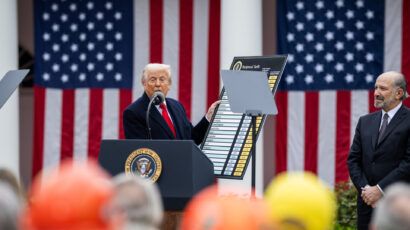Deconstructing the meaning of Iran’s 20 percent uranium enrichment
By Ivan Oelrich, Ivanka Barzashka | May 19, 2010
On February 11, the 31st anniversary of the Islamic Revolution, Iranian President Mahmoud Ahmadinejad delivered the “sweet” news that Iran had successfully produced 20 percent enriched uranium. More than anything, the announcement served as Iran’s response to the stalemate over purchasing fuel for the Tehran Research Reactor that is used, in part, to produce medical isotopes. The United States–which has pushed for tougher sanctions against Iran since the beginning of 2010, when President Barack Obama’s deadline for engagement expired– dismissed Ahmadinejad’s announcement as a simple act of defiance. The White House questioned Iran’s ability to enrich to such levels, calling the Iranian president’s statement likely “based on politics, not on physics.” By the end of February, however, Iran’s achievement was confirmed by the International Atomic Energy Agency (IAEA). And it is a hefty achievement that should not be taken so lightly.
Enrichment to 20 percent would be the first step in the domestic production of fuel for the country’s research reactor. At the same time, it’s a potentially dangerous development: A stockpile of 20 percent enriched uranium would cut by more than half the time needed to enrich to levels above 90 percent–levels that are necessary for a bomb. While Iran is perfectly capable of enriching to higher degrees, our assessment shows that it isn’t yet serious about producing 20 percent enriched uranium and domestically manufacturing fuel for its research reactor. Instead, its actions are likely intended to gain political leverage over the fuel deal and not meant as a leap toward a nuclear weapons capability at this stage.
Fueling the Tehran Research Reactor. Ahmadinejad’s February announcement was not completely shocking news. Since the end of 2009, Tehran has warned that it will start producing 20 percent enriched uranium unless a deal to purchase the material is struck with the United States, France, and Russia. In June 2009, Iran approached the IAEA with a request to seek vendors for fresh fuel. During his visit to the United Nations in September 2009, Ahmadinejad announced Iran’s need to refuel its research reactor and its willingness to buy nuclear fuel from anyone–including the United States. In response to a U.S. proposal–and despite domestic opposition–Tehran agreed to give its own low-enriched uranium (LEU) in partial payment for fuel rods. For the states worried about Tehran’s nuclear intentions, a reduction of Iran’s LEU stockpile would be good news, as this could mean that it would take Iran longer to manufacture a nuclear weapon. Although in principle not a necessary requirement for the purchase of nuclear fuel, the exchange is now the basis of a deal with potential sellers; however, Iran and the international community haven’t been able to agree on the details of how the swap should be achieved. Tehran is steadfast that the exchange takes place on its own soil, whereas the United States, France, and Russia insist that Iranian LEU be kept by a third party, like Turkey, until the fuel rods are ready for delivery.
Faced with this deadlock, Tehran started its production of 20 percent enriched uranium, which is required to make fuel for its research reactor. Iran has the technical knowledge and infrastructure to produce the fuel elements domestically, but this will be expensive and not without risk. Though Iran has some limited experience producing fuel elements for its heavy water reactor, it would be venturing into new territory by producing fuel for the research reactor. The Iranians haven’t finished constructing production lines for conversion of enriched uranium into either pure uranium oxide or oxide pellets. (There are also unsubstantiated reports that Iran’s enriched uranium is contaminated with molybdenum, which would require additional purification.) Further, it is not evident that they can produce the cladding that encapsulates reactor fuel elements. For these reasons, Iran is still interested in buying fuel.
Even if Iran has the potential to make the fuel elements itself, could it do so before its reactor runs out of fuel? Argentina provided 115.8 kilograms of fuel for the reactor in 1992, and Iran’s Atomic Energy Organization says that fuel is “about to finish.” Iranian officials have even warned that if fuel is not supplied soon, treatment for some 850,000 cancer patients will be jeopardized. In a letter to the IAEA, the U.S., Russia, and France stated that Iran “cannot produce the needed nuclear fuel in time to ensure the uninterrupted production of isotopes.” But Iran will not likely run out of fuel soon. The Tehran Research Reactor has a maximum power of 5 megawatts; as of 1998, the reactor was operating at about 60 percent of its maximum capacity and for only about 100 days a year, according to the IAEA. Even if we assume that, since 1998, Iran has ramped up the reactor’s operation close to maximum power (which we judge to be highly unlikely), that would mean that the country would probably run out of fuel sometime this year. On the other hand, if Iran has continued running the reactor at a more moderate capacity, its remaining fuel might last for nearly a decade.
Although we can’t say for certain when the country’s research reactor will run out of fuel, Tehran is probably not as pressed for time as has been portrayed by not only Iran, but by the U.S., UK, and France. In fact, according to Iran’s top Atomic Energy Organization official, Ali Akbar Salehi, they have “worked out a detailed timeline to deliver the fuel to the Tehran Research Reactor in due time.” This means that, although Iran has no experience manufacturing the fuel rods itself, it might have time to figure out the process. (It may be less compelled, and less pressured, to accede to the U.S. version of the deal.)
So the question remains: If interruption of the reactor’s operation or a medical isotope shortage isn’t an immediate worry, why, then, has Iran been so quick to enrich to 20 percent? Its enrichment effort could be an attempt to force a favorable outcome to the fuel deal, or it could be a push toward a weapons capability. We will examine both possibilities.
Enrichment at its pilot plant. Although manufacturing fuel rods may present some challenges for Iran, enriching to 20 percent isn’t a big technical hurdle. Currently, the enrichment takes place in a single cascade of 164 so-called IR-1 centrifuges at Iran’s Pilot Fuel Enrichment Plant at Natanz, where Iran tests its new centrifuge models. Instead of starting with uranium at natural concentrations, Iran uses its existing stockpile of LEU as feedstock. (We know this for a fact since, according to IAEA reports, Iran transferred LEU from its main industrial facility to the pilot plant: Initially, about 10 kg of LEU was transferred; later, 1950 kg was transferred, accounting for the majority of its current stockpile.) This allows Iran to use exactly the same proven centrifuge design it has employed so far to enrich natural uranium to LEU without having to re-pipe the machines. Our calculations show that by simply feeding LEU instead of natural uranium into any one of its current centrifuge cascades, the product is very close to the required 19.75 percent–meaning that we can use past performance of the IR-1 cascades to estimate the future production of 20 percent enriched uranium.
In the single cascade at the pilot plant, Iran can produce about 1.3 kilograms of 20 percent enriched uranium every month, which is almost certainly more than what the reactor consumes during the same time period. If the reactor were operated at maximum power for approximately 100 days, as has historically been the operation time, the Tehran Research Reactor would consume almost 0.64 kilograms per average month of operation. Thus, in theory, one 164-machine cascade could produce more than twice what the research reactor consumes each month, which is consistent with comments made by Iran’s representative to the IAEA.
In practice, the current setup is likely not the best option for fuel production. A single cascade would take more than seven years to replace the entire amount of fuel that Argentina sold to Iran; further, that single cascade would take a little more than 18 months to produce 27 kilograms, enough for one reactor core of fuel. If Iran isn’t running out of fuel anytime soon, it could, in theory, be enriching small quantities of uranium, while concurrently mastering the fuel element fabrication process and then produce fuel elements. In practice, however, such a prolonged enrichment process is almost certainly not efficient. Indeed, from a production efficiency standpoint, it is probably best to master the fuel manufacturing process and then put several cascades at Natanz to quickly produce the required 20 percent enriched material in as little as several months.
Iran’s breakout potential. If Iran’s claim that it’s enriching uranium to produce fuel for its research reactor is suspect, then we must examine the possibility that Tehran is intentionally moving toward a weapons capability. Although 20 percent enrichment is legal under the Nuclear Non-Proliferation Treaty, it brings Iran a step closer to producing 90 percent enriched, bomb-grade uranium.
A stockpile of 20 percent enriched uranium increases the breakout threat in two ways. First, by starting with 20 percent LEU–rather than the current stock of 3.5 percent–Iran cuts the time required to produce a bomb’s worth of material by more than one-half. Second, a higher degree of enrichment means that a smaller quantity of material presents a weapons threat. To make a bomb’s worth of highly enriched uranium, Iran would need to start with more than 5 tons of natural uranium or about 1 ton of its 3.5 percent LEU. But if it starts enriching with 20 percent enriched uranium, it would only need 130 kilograms. (All of these numbers depend on assumptions about the amount of uranium 235 lost in the waste, which tends to be high in Iran’s operations.)
If Iran were looking to increase its breakout potential, however, producing 20 percent enriched uranium with only one cascade wouldn’t be a viable option. It would take more than eight years to produce 130 kilograms of 20 percent material. That said, safeguards are being tightened to ensure that smaller diversions of material could be caught faster just in case.
Flexing its enrichment muscles. Our calculations show that Iran’s plan to enrich uranium to 20 percent in a single cascade is likely not the best option for fuel production, but it’s also hardly a great advancement toward a weapons capability. If Iran wanted to quickly produce the amount of material needed to fuel the Tehran Research Reactor, it could legally use the entire 23 cascades currently operating at the Fuel Enrichment Plant at Natanz, where it would take only four months to produce the 115.8 kilograms required to fuel the reactor for about 20 years. It would take less than another month to produce enough 20 percent material to make bomb-grade uranium, ultimately reducing the time to a weapon by one-half. But Iran has shown no indication that it wants to expand that capacity.
If 20 percent enrichment were strategically important, not only would Iran want to stockpile the material quicker, but it also would proceed with the enrichment in a better protected location than the aboveground pilot plant. It wouldn’t have to go far either: The main fuel enrichment halls that contain the 23 operating cascades are located only meters away and are protected underground.
An obvious sign of posturing was Iran’s decision to move the majority of its LEU stockpile to the pilot plant at Natanz. It would take a single IR-1 cascade over 10 years to enrich the entire amount of material. This was not a production decision, but a way to show that Iran’s intentions were serious. (After media reports expressed dismay at Iran’s decision to move nearly all its enriched uranium to a location more vulnerable to an air attack, the material was quickly moved back.)
Despite having started enriching to higher concentrations, Tehran has said that it is still interested in buying fuel from abroad and will stop enriching to 20 percent once a deal is made. But Iranian officials warn that if international sanctions against the Islamic Republic are passed, the fuel swap deal would be off the table.
According to the latest IAEA report, Iran hasn’t begun setting up production lines for the Tehran Research Reactor at its fuel fabrication plant. It will take time to do so, since poor-quality fuel elements can cause a dangerous and expensive reactor accident. Iran has no experience manufacturing precision fuel rods for a research reactor and has said it will proceed “with more caution.” For these reasons, we don’t find that, currently, Iran is serious about fabricating fuel rods for its research reactor or dramatically increasing its ability to move toward a bomb.
At this stage, 20 percent enrichment is likely only a show of force in an attempt to speed up a favorable fuel deal. However, we must reiterate that this doesn’t mean that 20 percent enrichment should be taken lightly. Prolonged negotiations to refuel the medical isotope reactor have provided Iran with an excuse, even a humanitarian one, to enrich to higher concentrations. Iran can easily use its existing enrichment capacity to quickly increase the rate of 20 percent production in response to sanctions or simply in an attempt to be more efficient in producing fuel for its research reactor. And a stockpile of 20 percent enriched uranium would significantly reduce Tehran’s time to a bomb. But this is not an irreversible development. At least, it isn’t yet.
Together, we make the world safer.
The Bulletin elevates expert voices above the noise. But as an independent nonprofit organization, our operations depend on the support of readers like you. Help us continue to deliver quality journalism that holds leaders accountable. Your support of our work at any level is important. In return, we promise our coverage will be understandable, influential, vigilant, solution-oriented, and fair-minded. Together we can make a difference.
Topics: Nuclear Energy, Nuclear Weapons, Opinion
















